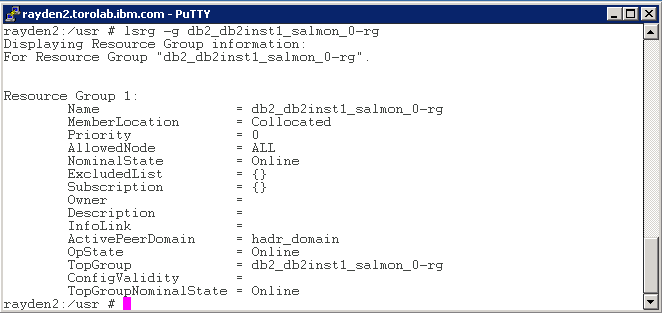  hadr_start.ksh, hadr_stop.ksh, hadr_monitor.ksh: These three scripts are registered as part of the TSA automation policy for TSA to monitor and control the behavior of the HADR database pair. Example 9-11 is the script for hadr_start.ksh: hadr_start.ksh, hadr_stop.ksh, hadr_monitor.ksh: These three scripts are registered as part of the TSA automation policy for TSA to monitor and control the behavior of the HADR database pair. Example 9-11 is the script for hadr_start.ksh:
Example 9-11 hadr_start.ksh

......
###########################################################
# starthadr()
###########################################################
starthadr()
{
set_candidate_P_instance
instance_to_start=${candidate_P_instance}
HADR_partner_node_state
$SVC_PROBE ${DB2HADRINSTANCE1?} ${DB2HADRINSTANCE2?} ${DB2HADRDBNAME?} ${VERBOSE?} S
rc=$?
if [[ $remote_node_alive == "Online" ]]; then
# Bring up HADR as Primary on this node
if [ $rc -eq 1 ]; then
# already primary
rc=0
elif [ $rc -eq 2 ]; then
# currently standby,peer
# takeover (no force)
logger -i -p notice -t $0 "su - ${instance_to_start?} -c db2 takeover hadr on db ${DB2HADRDBNAME?}"
su - ${instance_to_start?} -c "db2 takeover hadr on db ${DB2HADRDBNAME?}"
$SVC_PROBE ${DB2HADRINSTANCE1?} ${DB2HADRINSTANCE2?} ${DB2HADRDBNAME?} ${VERBOSE?}
rc1=$?
if [ $rc1 -ne 1 ]; then
:
logger -i -p err -t $0 "*** Database ${DB2HADRDBNAME} is in Peer State, TAKEOVER FAILED"
# Old primary node is still online, offline instance to prevent split-brain
# Uncomment following 3 lines to allow takeover by force
#chrg -o Offline -s "Name = '${forceRGOfflineInCaseOfByForce?}'"
#su - ${instance_to_start?} -c "db2 takeover hadr on db ${DB2HADRDBNAME?} by force"
#logger -i -p notice -t $0 "NOTICE: Takeover by force issued, old primary instance offlined to prevent split brain"
fi
elif [ $rc -eq 40 ]; then
:
logger -i -p err -t $0 "*** Database ${DB2HADRDBNAME} is not in Peer State, old Primary machine still Online"
//-fi³ƒ°£°£°£°£°£°£
# Uncomment following 3 lines to allow takeover even in case of non Peer Standby w/ old Primary machine Online
#chrg -o Offline -s "Name = '${forceRGOfflineInCaseOfByForce?}'"
#su - ${instance_to_start?} -c "db2 takeover hadr on db ${DB2HADRDBNAME?} by force "
#logger -i -p notice -t $0 "NOTICE: Takeover by force issued, old primary instance offlined to prevent split brain"
else
# current state of HADR is unknown
# eg. If instance has just gone down, wait until it's 2*monitor period
# so that instance can be restarted and db ACTIVATEd
sleep 20
fi # Bring up HADR as Primary on this machine
else
# Old primary machine is offline
if [ $rc -eq 2 ]; then
# Standby is currently in Peer State
#
# To bring up standby, will now do a TAKEOVER BY FORCE
# No need to block until resource group is offline, we have verified
# that the node is down already
# To bring up standby, will now do a TAKEOVER BY FORCE
:
logger -i -p notice -t $0 "su - ${instance_to_start?} -c db2 takeover hadr on db ${DB2HADRDBNAME?} by force"
su - ${instance_to_start?} -c "db2 takeover hadr on db ${DB2HADRDBNAME?} by force "
logger -i -p notice -t $0 "NOTICE: Takeover by force issued"
elif [ $rc -eq 40 ]; then
# Standby is currently not in Peer State
:
logger -i -p err -t $0 "*** Database ${DB2HADRDBNAME} is not in Peer State, old Primary machine Offline"
# Uncomment following 3 lines to allow takeover even in case of non Peer Standby w/ old Primary machine Online
//-fi³ƒ°£°£°£°£°£°£
#logger -i -p notice -t $0 "su - ${instance_to_start?} -c db2 takeover hadr on db ${DB2HADRDBNAME?} by force"
#su - ${instance_to_start?} -c "db2 takeover hadr on db ${DB2HADRDBNAME?} by force "
#logger -i -p notice -t $0 "NOTICE: Takeover by force issued"
fi
fi # Bring up HADR on this machine
# Return state
$SVC_PROBE ${DB2HADRINSTANCE1?} ${DB2HADRINSTANCE2?} ${DB2HADRDBNAME?} ${VERBOSE?} S
rcs=$?
# Online succesful must return 0 whilst monitor returns 1
# for Primary in Peer State and 3 for Primary not Peer
if [ $rcs -eq 1 ]; then
rc=0
elif [ $rcs -eq 3 ]; then
rc=0
# Anything else, map directly from monitor
else
rc=$rcs
fi
return $rc
}
......

Take the following steps:
| 
 regdb2salin: This script registers the DB2 instance into the TSA cluster environment as a resource.
regdb2salin: This script registers the DB2 instance into the TSA cluster environment as a resource.






